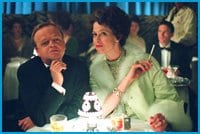It is impossible to discuss Douglas McGrath’s new film Infamous without referring to Bennett Miller’s Capote, as it focusses on the same events in the writer Truman Capote’s life, but in a very different style. Where Miller’s Capote was a subtle and restrained underdog, McGrath’s Infamous is a rouged and feathered diva: Every Park Ave apartment and Kansas bungalow is stuffed with pricey period detail and performances by a who’s who of stars (including Sigourney Weaver and Isabella Rossellini) that go for grandstanding over incisiveness.
Infamous is not a bad film — excess certainly has its pleasures — but it can’t help but feel like a more spectacular, brasher and in many ways more emotionally diluted experience than its predecessor which blew away audiences not one year ago.
I nearly ate my own eye when I heard that Sandra Bullock would play Nelle Harper Lee. With intentions pure and precious, I’m sure, she studiously avoids making Lee into Miss Congeniality 3 — but goes for Forrest Gump, instead. She speaks like a slow-witted, southern Yoda, a woman of unadulterated virtue always with a homespun pearl of wisdom at the ready; she doesn’t know what to do with herself when sharing the frame with her far sassier compadre.
Replacing soul-baring with showboating, Toby Jones delivers an undeniably bravura performance as Capote. A jowly, small pug of a man, this sharp-tongued queen of high society is an immensely entertaining caricature, with a gloriously mosquito-pitched voice and a high-femme manner that gets him perpetually mistaken for a “ma’am.” In one of his only demonstrations of virtuoso directing, McGrath cuts from rendezvous to rendezvous as Capote recounts the same juicy gossip — with variations and adjustments, of course — to different companions. This very effectively captures this blond butterfly’s huge social capital, his expertise at telling a story and at influencing others to dispense their deepest secrets.
The film continues to impress when he and Lee head to Holcomb, Kansas to write about the brutal murder of the Clutter family, which will become his groundbreaking nonfiction novel In Cold Blood. Jones really shines when he hits town and starts sparring with the decidedly unglamorous locals — including a plumped-up Jeff Daniels as Det Dewey, whom Capote affectionately comes to nickname “Foxy” — finally realizing that they can be won over with tales of hobnobbing (and arm-wrestling) with Hollywood royalty.
Unfortunately, once the killers are captured the film settles into predictability and the script gets clunky and uneven. The way McGrath stages the fraught third-act relationship between Capote and the soulful killer Perry Smith (an unrecognizable Daniel Craig) is so ham-fisted it verges on the histrionic. Jones does better with Capote’s wry and often very affecting gay wit than bearing McGrath’s rushed and conventional rendering of Capote’s selfish parasitism, hypocrisy and moral anguish.
Another distinction from the film Capote is that Infamous sacrifices insight into its protagonist’s inner psyche for the opinions and insights of his minions, for example using staged documentary-style “interviews” with his associates such as hammy-as-hell Peter Bogdanovich as publisher Bennett Cerf and a wonderful Juliet Stevenson as fashion icon Diana Vreeland (she clearly relishes each syllable of her fabulous zingers). This tactic contributes to the film’s scrutinizing of the messy mash-up of truth and lies that went into every Capote yarn, not just In Cold Blood.
There are many great moments in Infamous, which is why such missteps are so disappointing; the direction should be as smart, surprising, daring and resonant as the best of Capote’s own words.


 Why you can trust Xtra
Why you can trust Xtra


